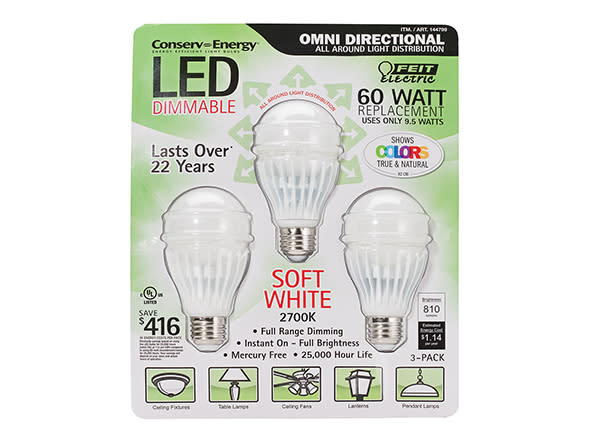How to read a lightbulb label
Now that incandescent lightbulbs have largely been replaced by energy-saving LEDs and CFLs, a trip down the lightbulb aisle can be confounding. Not only are the lightbulbs different but the terms used to describe them are too. Fortunately, if you take some time to read the labels, you can find the right lightbulbs for your fixtures. Here's a lightbulb lingo decoder from the pros at Consumer Reports.
Light appearance
Differences in light color are easy to see. Warm yellow light, similar to an incandescent, has a color temperature around 2700K. (The K is for Kelvin, a temperature scale that measures light color.) Most Energy Star qualified bulbs are in the 2700K to 3000K range. Bulbs 3500K to 4100K cast a whiter light, and those 5000K to 6500K give off a bluer-white light.
Energy used
Watts tell you how much energy the bulb uses. So a 10-watt LED that provides the same amount of light as a 60-watt incandescent saves you energy and money.
Lumens
The more lumens, the brighter the bulb (think luminous), but many of us still think in terms of watts. For bulbs used in lamps and ceiling fixtures, known as A-type, 800 lumens provide light as bright as a 60-watt incandescent; an 1,100-lumen bulb replaces a 75-watt one; and 1,600 lumens are as bright as a 100-watt bulb.
Life
Unlike other bulbs, LEDs typically don’t burn out. Instead, the light fades over time and is considered useful until it’s decreased by 30 percent. It’s that useful life, in years, that you’ll see on the label.

Energy Star
Bulbs carrying the Energy Star label are independently certified to ensure that they meet high standards. Warranties must be longer than the industry norm—at least three years for LEDs and two for CFLs—and the Star may help you earn rebates from your utility, so check out energystar.gov/rebate-finder.
Mercury-free
That’s true for all LEDs. CFLs do contain mercury. Though the amount is small and has decreased substantially, CFLs should be recycled to keep mercury from being released into the environment when bulbs break in the trash or a landfill. If a CFL breaks at home, follow the cleanup tips from the Environmental Protection Agency.
Notice
Lighting Science, an LED manufacturer, has added a warning to its packages that says, “Exposure to certain electric lights may cause biological effects, some potentially disruptive.” That’s scary, vague, and a way to sell LEDs with less blue light. Studies have shown that exposure to any light at night is associated with an increased risk of sleep problems, and eyes are especially sensitive to blue light, which LEDs emit more of. Bulbs with a light color around 2700 kelvins are a better choice.
CRI
Ever look at yourself in light that makes your skin tone look weird? A bulb’s CRI, or color rendering index, tells you how accurately colors appear under the bulb’s light. It ranges from 0 to 100. Halogen, a type of incandescent bulb, is often around the perfect 100. Most LEDs and CFLs we’ve tested are in the 80s, with a few in the low 90s.
Omnidirectional
LEDs cast light only in a specific direction, unless advanced engineering was used to design the bulbs, enabling them to shine in all directions. Such omnidirectional A-type bulbs are ideal for lamps.
Shop right
Divide and conquer. PARs and BRs, the bulbs used in recessed lighting fixtures or floodlights, have a number such as 30 or 64 in their description. Divide by 8 to learn the bulb’s diameter in inches. You’ll need that number when picking bulbs for your fixtures.
Consider the dimmer. Most LEDs are dimmable, but some flicker and make noise when lowered. Improve compatibility by using a dimmer recommended by the LED manufacturer, usually listed on its website.
Be a matchmaker. Don’t leave home without your old bulb. It’s a sure way to know that the LED fits your fixture, because some are bigger or heavier than other bulb types.
Use as intended. If an LED is used in an enclosed fixture but wasn’t designed for it, the bulb can overheat and begin to dim, change light color, or fail earlier than expected. We note in our lightbulb Ratings which LEDs manufacturers say can be used in fully enclosed fixtures. Many of our tested LEDs and CFLs can work outdoors but must be shielded from water, so check the package.
Separate types. Don’t use both CFLs and LEDs in the same fixture if a lamp takes multiple bulbs and has a dimmer. That can disrupt interaction between bulbs and dimmer, causing flickering and flashing.

This article also appeared in the October 2015 issue of Consumer Reports magazine.
More from Consumer Reports:
The best energy efficient air conditioners
5 terrific side by side refrigerators
Best places to buy large and small appliances
Consumer Reports has no relationship with any advertisers on this website. Copyright © 2006-2015 Consumers Union of U.S.


